Headspace App Review – How To Win Friends, Influence People and Improve Your Health With Meditation
We include links to products we think are useful for our readers. If you click and buy a product through one of the affiliate links on this page, we may earn a small commission.
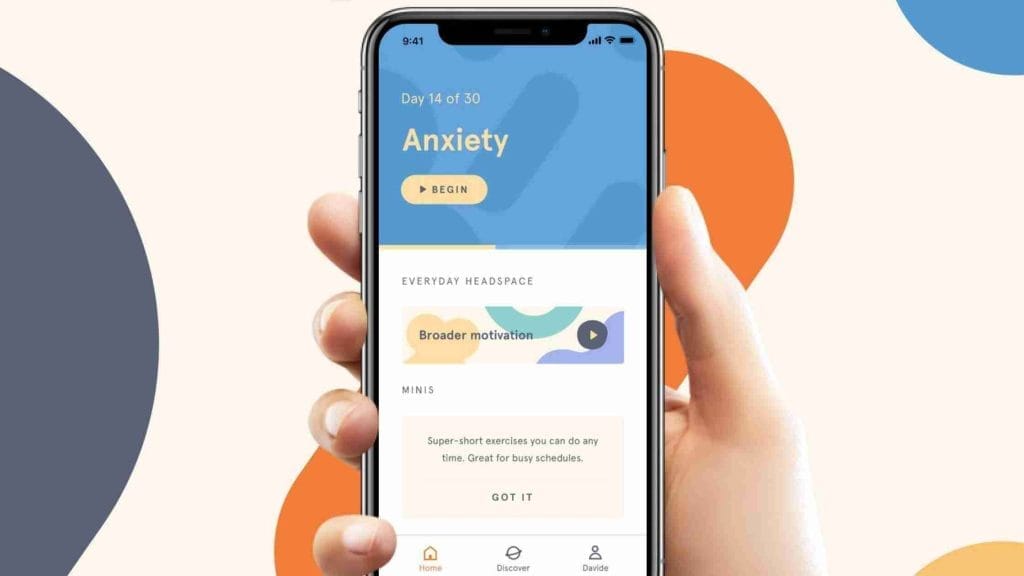
Headspace App Review 2024
We review Headspace, the best meditation app in your pocket for starting and continuing a meditation practice
The Headspace App has saved me many times. Life is intense at times and if you are aware of the benefits of meditation and practice meditation regularly, you know what a difference it makes to have a meditation app on hand for a guided meditation to destress and calm down.
Making mental health a priority and dedicating time to actually switch off is important for brain chemistry and is something that is made much easier with guided mindfulness techniques found on apps like Headpsace.
In this Headspace App review, we get into the nitty gritty of why the Headspace meditation app is one of the best meditation apps to download in 2024. Guided meditation apps like Headspace have millions of downloads on Iphone and Android each year and it is fantastic that these mindfulness apps have brought a greater awareness to meditation and reduced the stigma or ‘woo, woo’ views of meditation as a practice.
Meditation and indeed using a guided meditation on an app like Headspace, has been scientifically tested time and time again to give a whole range of benefits to the conscious seeker in areas related to mental health, learning and memory, executive function, impulse control, recovery from injury, improved sleep and better weight management.
For people who struggle switch off and find a sense of calm with a racing mind, Headspace offers a simple method to guide you through techniques that will convert even the biggest meditation sceptics.
What are the benefits of meditation and mindfulness?
The benefits of meditation have been studied for centuries and have some impressive modern science backed results. Mindfulness and meditation is ancient practice and, no surprise, have been used long before meditation apps were available. Meditation has been shown in studies to:
Enhance cognitive health
Lower perceived stress levels
Improve pain tolerance
Improve executive function
Increase emotional intelligence
Decrease anxiety and depression symptoms
Improve sleep health
Decrease the need for medications relating to attention in kids and adults
Increase sense of wellbeing
Improve management of addiction and addictive behaviours
With all of these benefits of meditation in mind, let’s get into talking about our experience with one of the most popular meditations app to have in your pocket – Headspace.
Headspace App Review 2024

What is Headspace?
Observing the thoughts and feelings without judgement or attachment is the foundation of most mindfulness practices and Headspace works off the same concept. The Headspace app, like many of it’s counterparts in Waking Up, Buddhify, Breathe, Unplug, Insight Timer and Calm, can all be considered mindfulness-based stress reduction (MBSR) and mindfulness-based cognitive therapy (MBCT).
Read Also: Best Coffee Alternatives 2024 To Calm The Mind
These digital methods of meditation have confirmed science backed benefits and have really exploded in popularity as more and more athletes, high performers, military and the general population attest to positive results.
Headspace has the claim to be one of the highest downloaded meditation apps in the world in 2024, not to far behind its main competitor, Calm, which we have also used extensively for meditation.
The brains behind Headspace is Buddhist monk, Andy Puddicome, who was definitely a soothing voice for me in the initial stages of learning to meditate through apps and presented a challenge in not falling asleep, which is definitely not the main goal of meditation (unless of course you are listening before bed to fall asleep!). The app, which is available for download on both IOS and Android, has both free and paid sections of the app that offers practice reminders, an easy user interface, and a huge variety of both practice style and guiding voice/person.
Headspace Pros
Well priced subscription with savings for multiple users
Available on both Android and IOS
Very easy to use interface
Some free content
Statistics and data tracking for progress and accountability
Guided by some world class athletes and meditation gurus
Share your journey with a friend or multiple people
Headspace Cons
Somewhat expensive subscription compared to other apps
Free trial still requires credit card and auto-renewal feature
More geared toward beginners and lacks advanced practice
Could be updated more regularly
How much does Headspace cost?

Headspace offers some of its content for free. However, when downloading the Headspace App, you will be required to input your credit card details and be placed on an auto-renew setting regardless of whether you would like the free content or full access to the subscription content.
Although, this auto-renew setting can easily be disabled by heading to your App purchases area in the phone and disabling auto-renew to allow you to just access the free 7 day trial of Headspace. For those looking to subscribe, the cost of Headspace is quite reasonable at all levels when it is broken down into a daily amount which really puts into perspective the small amount you are paying for a high quality meditation app.
A membership for Headspace Plus is only $12.99 per month and comes with a free 7-day trial so you can test out all the functions and basic features including access to over 500 guided meditations.
The other option is the annual subscription, which we went for, that costs $69.99 and includes a free 14-day trial. When you break this down into a daily rate, you are getting full access to a stellar meditation app for just under $0.20 per day which we find a no-brainer for the return you get for a regular meditation practice.
If you fall into the category of student, teacher, school administrator or staff in the USA, UK, Canada or Australia, then you qualify for Headspace at a tiny cost of $9.99 per year. This is feature of the Headspace App that I am very supportive of and makes Headspace App my preferred meditation app for this reason alone. It would be great to see this offering extended to military and first responders too.
The subscriptions can be set to auto-renew on your account or can be disabled if you are planning on just trying out the meditation app for the free trial or for one billing cycle of a month or a year. It is highly recommended to disable auto-renew and instead get reminders by Headspace that your subscription is nearing the end instead of getting a surprise transaction when you’ve forgotten about your subscription after a year.
How Headspace app works?
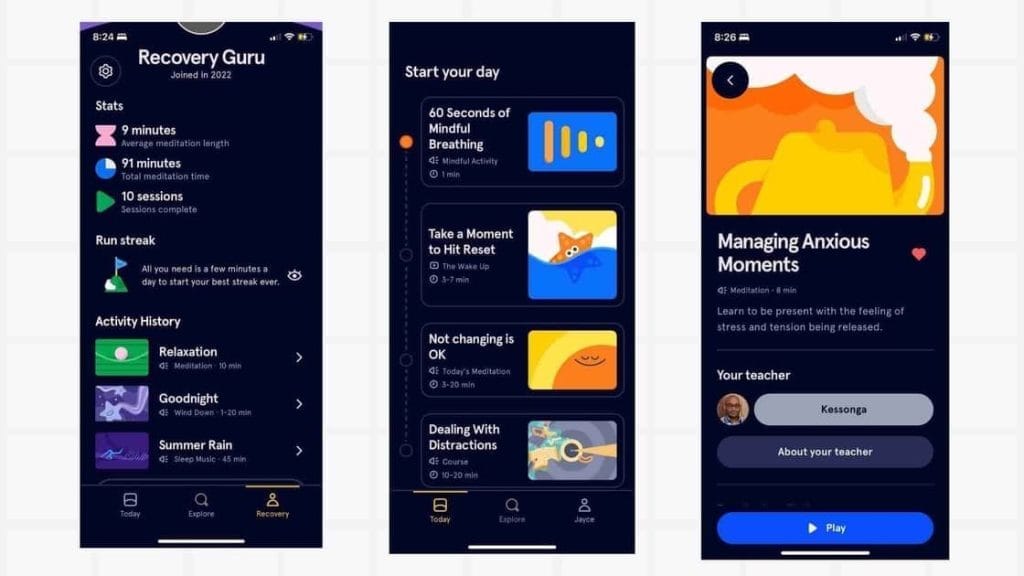
On downloading the Headspace App you will be prompted to create an account by inputting some personal details like name, email and credit card details. After this, Headspace greets you with some informative video content to set the scene for why meditation may be good for you and what the basic goals are for meditation.
The app interface is broken up into ‘Today’, ‘Explore’ and your profile. ‘Today’ provides somewhat of a timeline of your day to inject some brief mindfulness practices in and is further broken down into ‘Start your day’, ‘Your afternoon lift’, and ‘At night’. This is a great shortcut feature of the Headspace app that we have not really seen on many of the other meditation apps reviewed. These guided moments can be as short as 60 seconds or as long as 60 minutes, offering a suitable timing choice for any schedule.
Under the Explore banner, some of the common features include Meditate, Sleep, Move and Music. These titles allow you to jump to guided meditations dedicated to a particular goal or focus like improving sleep and winding down for bed. The graphics on Headspace also make it super kid-friendly and we would definitely place this app high on the list for best meditation apps for children.
Below this, Headspace users can pick from other popular subsections like newly added meditations, or more specific topics like Mindful Money, Guided Breathwork, Mindful Eating, Mindfulness at Work, Navigating Injustice, Beginning Meditation or Eve’s Guide To Sleep. Essentially, each main section of the Headspace App is like a short course for meditation. Within each short course, you have the ability to choose from a couple of different teachers, select your level and also allows you to download every session to be able to meditate while offline, on a flight or out of reception range. This is perfect for people working in remote areas, catching long haul flights, working at sea for long periods of time or just travelling around without regular reception.
Using Headspace meditations for better sleep

Meditations for sleep
One of the most used features on Headspace, according to the thousands and thousands of Headspace reviews, is the guided sleep focussed meditation. Many people struggle to fall asleep and stay asleep, with insomnia being one of the most common ailments in our modern world. Ironically, Headspace is accessed on the very device that may be the source of many people’s sleeplessness and chronically stimulated brains from social media, news feeds and a constant source of blue light, however this is not to take away from the benefits of meditating with an app.
Related Article: The Best Infrared Sauna Blankets of 2024
The sleep section of the Headspace app includes 30 individual sessions, guided by either Andy or Eve, that can be practices in either ten or twenty minutes in length. What I find, is that the biggest challenge meditating before bed for sleep is to actually stay conscious and not fall asleep.
I tracked some sleep stats on Apple Watch while using the Headspace App sleep course and within the first two 20 minute session, sleep latency or the time taken to fall asleep, significantly decreased by about 5 minutes. Following a guided voice really allows you to switch off the mind and be prompted to in the right ways to achieve a calm state of mind to fall asleep quickly.
By the time I had worked through to the Master section of the sleep course, average sleep time had increased by 25 minutes to 7 hours and 35 minutes, edging closer to the recommended 8 hours sleep every night. Other metrics that improved using the Headspace App included Readiness (to perform or train), less sleep disturbances, lower mid range heart rate and overall higher heart rate variability (HRV), which are all great measures of health and recovery levels.
Using Headspace to reduce stress and anxiety

Check in on your mood with Headspace
Meditation apps are very effective at helping lower stress and reduce anxious thoughts and overall symptoms of anxiety. Meditation is definitely not a cure for depression or anxiety however research has shown its efficacy for improving a diverse range of medical and psychiatric conditions including chronic pain, depression, eating disorders, anxiety fibromyalgia and cancer.
Read Also: The 5 Best Ice Bath Tubs For Cold Plunge
The Managing Anxiety course or the Take Control of Stress course would be a great place to start on the Headspace App if this is your individual goals for meditation. The Take Control of Stress Course is guided by Kessonga, a mindfulness meditation teacher at Headspace, and requires just 10 minutes a day.
In Week 1, the course allows you to get to know your stress by defining your goals, understanding the physiology of stress and stressful situations, as well as confronting your inner critic. Week 2 encourages you to manage setbacks by unpacking the stressors in your life, providing tips on how to relax and how to engage in mindful physical activities. Week 3 guides you into mindful living by practicing curiosity, calming yourself down via the senses, fostering acceptance and recapping what you have learnt. Finally, Week 4 of the Stress course casts you into the future by anticipating a future challenge, creation of a maintenance plan and practicing self-compassion.
Overall, the stress and anxiety based meditation tools in the Headspace app are super effective and you can become consciously aware of how meditation can slow your heart rate, breath rate and calm the mind to release yourself from the grasp of anxious thoughts and attachment to things that would usually stress you out.
Using Headspace to heal from trauma, injury or illness
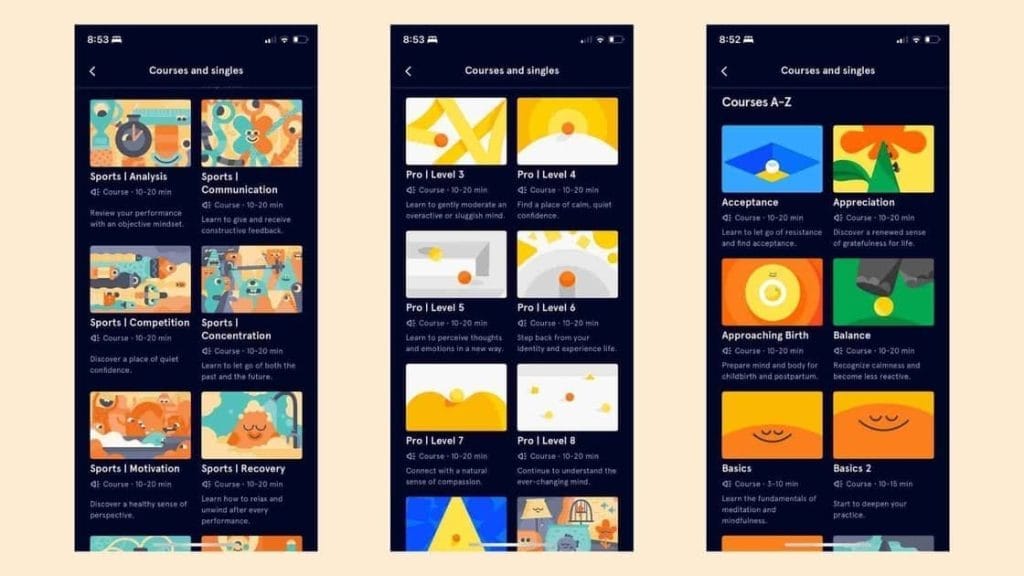
Headspace App has 500+ guided meditations
Trauma can come about from, physical injury, mental abuse or witnessing traumatic events. Many people live with the effects of traumatic injury with mild to acute symptoms and for some it can be severely debilitating. Meditation has been shown to be an effective treatment for conditions like post-traumatic stress disorder (PTSD). Recent meditation studies indicate that “mindfulness-based treatments may be effective in restoring connectivity between large-scale brain networks among individuals with PTSD, including connectivity between the default mode network and the central executive and salience networks.”
The Headspace app has multiple sections relating to healing from trauma, injury or illness. Headspace meditations focussing on tools for coping and managing these difficult parts of life can be accessed in the section Anger, Sadness and Growth which provides more specific guided meditations under ‘Life Challenges’. Here you can access meditations for Coping with Cancer, Grieving, Mindful Eating. Or you could see if anything resonates with you under the ‘Difficult Feelings’ section where you can find meditations relating to Handling Sadness, Dealing with Regret, Coping with Cravings and Pain Management.
There are also a great number of single meditations that go for 10 minutes which I personally love, and these can range in topics relating to trauma, injury or illness like Visualising Well-being, Managing Conflict, Connecting Mind and Body, Holding Anger with Kindness, Transforming Difficulties and many, many more.
Each of these specific meditations can be guided in anywhere from 3-20 minute session length which gives you the ability to inject moments of mindfulness through your day depending on how much time you have or how much time you feel you can focus your attention on meditation. This may get longer and longer, and progressively more enjoyable as you find consistency.
Using Headspace for sports, performance and focus

Meditation has been a practiced modality by athletes and high performers for centuries and many may not even know they are practicing. Although, a large portion of the competitive athlete world and their coaches are turning deliberately to meditation and mindfulness practices to enhance performance, focus and access visualisation techniques.
“Mindfulness meditation has met increasing interest as a therapeutic strategy for anxiety disorders”, this would include meditating for performance anxiety. Mindfulness interventions have been linked to improved sport performance and executive functions.
Mindfulness meditations have confirmed positive association with the much-sought-after ‘flow state’ or flow in athletes. Not only this, but the evidence suggest that mindfulness-based interventions are able to enhance sport-associated physiological activations, like salivary cortisol levels and immune responses, and psychological status indicators, like flow and anxiety reduction, as well as actual sport performances metrics like shooting accuracy and accuracy in other throwing movements like darts, tennis, baseball, javelin and volleyball.
There are specific guided meditation on the Headspace App suitable for those using Headspace for athletic performance or preparation for running a race, doing a competition like a marathon or adventure race, preparing for a military deployment, or preparing for an upcoming test of some sort.
Using headspace for relationships and emotional intelligence

Meditation is a practice widely recommended by psychologists, psychiatrists, relationship counsellors and other mental health practitioners. The reason being, meditation allows you access a higher state of being present in the moment, managing emotions and having a greater level of compassion for your partner, family member, friend and for yourself.
Studies have shown the positive effect meditation can have on emotional intelligence (EQ), perceived stress and negative mental health. Emotional intelligence is something that relates to how well one can perceive emotions in themselves and others to understand, regulate, and use such information in productive ways toward successful environmental adaptation and problem solving.
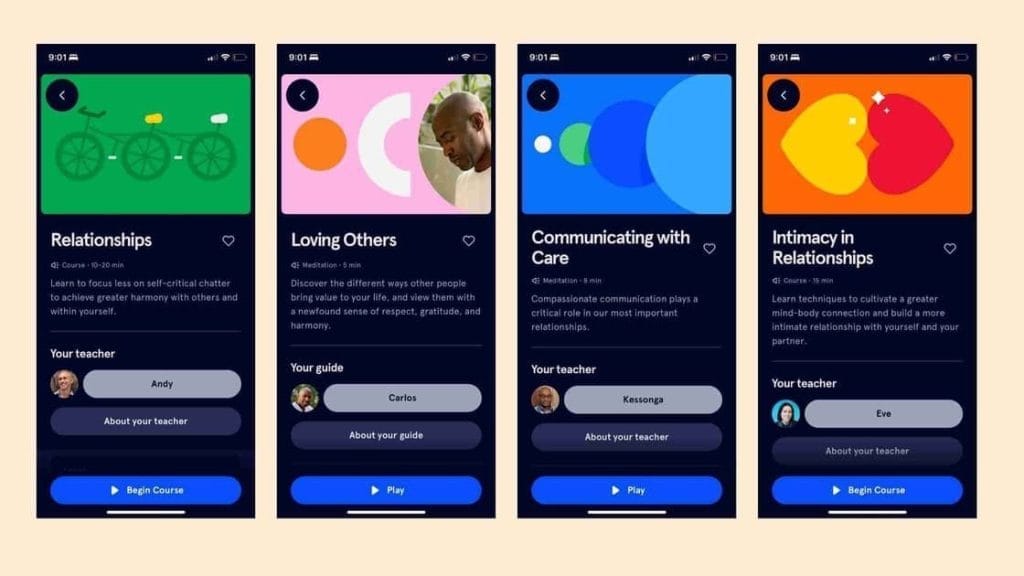
The Headsapce App has specific meditations to help improve relationships and understand emotions surrounding relationships. Relationship meditations range from 5 minutes to 20 minutes on the Headspace App and include some great sessions like Relationships, Intimacy in Relationships, Loving Others, Moving Beyond Shame, Communicating with Care and Solidarity and Connection.
Read Also: How To Win Friends and Influence People
Using Headspace for breathwork
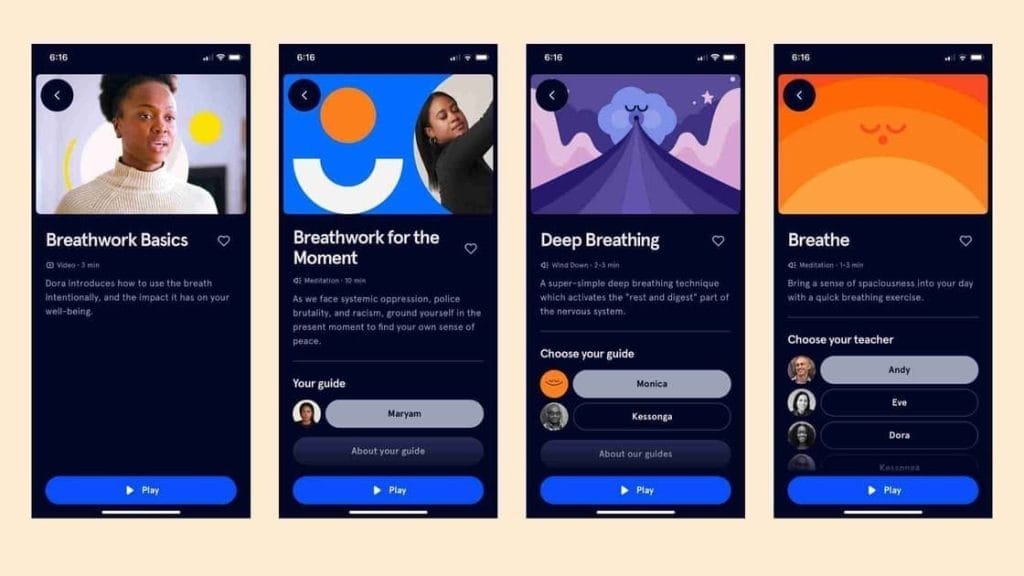
Connecting to the breath is a gateway to relaxation, faster recovery, better body awareness and even influencing the autonomic nervous system, as was demonstrated by Wim Hof in scientific studies conducted on him.
There are many different ways to consciously affect breathing and different breathing patterns and practices can have different physiological responses. Whether you are Wim Hof Breathing, Pranayama or ‘fire breath’, Box Breathing or Belly Breathing, each practice has the ability to influence factors like lung capacity, heart rate, temperature, energy levels, sense of wellbeing, anxiety levels and readiness for sleep and overall state of the nervous system. The breath is one of the most simple ways to take the body and mind away from a state of ‘fight or flight mode’, known as the sympathetic state, into a ‘rest and digest mode’, known as the parasympathetic state.
Headspace has a number of breathing focussed meditations, not surprisingly, as most meditation as rooted in the breath.
Headspace App FAQ’s
Who is the Headspace App for?
I would strongly recommend a meditation app like Headspace for anyone experiencing a stressful situation of some kind in their life or anyone who is looking to improve a particular area of their life. The Headspace app is also a must for anyone who:
Struggles to fall asleep or stay asleep
Struggles with anxiety, depression or mental health issues
Has experienced a traumatic event, death, injury or illness
Military, first responders, healthcare workers and those with high stress roles
Children
Those who are preparing for a race, event or performance
How long should you meditate for?
Although the goal of meditation is more-so to train yourself to be the aware but non-attached, non-judgemental observer of your thoughts and emotions, a good length of time to aim for according to experts is 10 – 20 minutes in duration. In saying this, the benefits of meditation can be achieved after just a few minutes, practiced consistently.
Is it ok to fall asleep during meditation?
If your main goal is to improve sleep, then falling asleep during meditation can’t be a bad thing at all. To achieve even greater benefits in the long term, remaining conscious and in a state of wakefulness (not necessarily alert), will give you more insight and allow to practice the techniques that make meditation so powerful rather than just fall asleep after a few minutes. By no means be upset about falling asleep from meditation, a good night’s sleep is just as beneficial, if not more beneficial, for repair, recovery, mental health and focus as meditation.
Is meditation good for kids?

Meditation is a safe and beneficial practice for all ages. My children meditate 2-3 times per week, often before meal-time, at dinner, and it is a great opportunity to break the fixation on social media, television, video games or another outwards focussed task and bring the kids’ minds into a reflective state, reconnect with themselves and usually turns out in a much more present meal experience than the nights when meditation isn’t practiced.
On the Headspace App, there are loads of guided meditations for kids and for the very young ones and babies you could even simply put on some of the meditation sounds or meditation music which can help put baby to sleep or calm them down. Under the section Parents and Kids, you will find some great parenting and children-centric meditations like Mindful Parenting, Care for Caregivers, Balancing Your Childs Emotions, Bedtime Meditations and Meditations for under 5, Meditations for 6-8 and Meditations for 9-12. In this way, Headspace offers a meditation subscription that can be used by the whole family which we love.
Getting kids to meditate can be a challenge. The best place to start is with demonstrating, kids are prone to copying the behaviour of their parents so leading by example will encourage them to adopt the practice. Keeping the meditation short and sweet is also a good idea, with experts saying ‘“one minute per year of age” is a good rule of thumb for meditation session length. Creating games and a creative space around meditation and curating a particular space in the house to support this can also have a great effect. A welcoming space that is not full of clutter and has a calming effect can be all the more encouraging for kids to meditate.
What is the best position to meditate in?
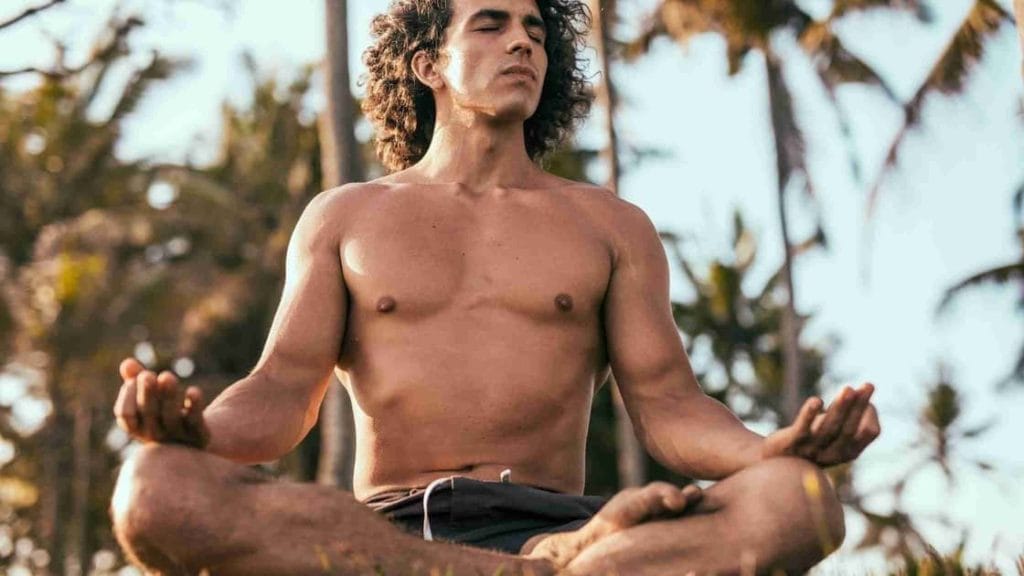
The best position to meditate is the position which allows you the most comfort and produces the least pain. A note on laying on your back for your favoured meditation position, if this position commonly causes you to fall asleep during the meditation, it would be beneficial for you to switch to an upright seated position. Unless the primary goal is to fall asleep, missing the whole meditation won’t afford you all of the potential benefits of meditation.
The quintessential meditation position of sitting upright with legs crossed is a one of the most highly recommended meditation positions as it encourages focus and correct posture. With the gaze steady angled slightly down with the chin tucked half way to the chest, hands resting lightly on the knees with palms facing up or down, this position is said to help limit the flow of thoughts and send the mind into a state of calm.
If this position is uncomfortable for you because of tight glutes, sore knees or sore lower back, you can also place a yoga block or a yoga cushion under your bum to help increase the angle between your knees and back, reducing some of the compression on the spine. Having a hard surface supporting the back to rest against can also be a little more comfortable for beginners, but a progression into self-supported, upright seated position is the goal.
When is the best time to meditate?
The best time to meditate is in the morning prior to any input or external influence from phones, emails, texts or business. I find extreme benefit from combining journalling and meditation practices together in the morning within 1 hour of waking. With meditating in the morning, it is important to have some degree of separation between sleep and wakefulness prior to meditating to avoid slipping back into sleep. Upon waking, stand up and walk around or move to another part of the house, take a drink of water, lemon water, MUD WTR or herbal tea before taking your desired meditation position, preferably off the bed.
Conclusion on Headspace App
The Headspace App is one of the best meditation apps for beginners and for those continuing with a consistent meditation practice. Headspace offers a great variety of meditations that are constantly updated and provide specific guided mindfulness coaching to benefit sleep, reduce tension and stress, reduce anxiety and anxious thoughts, improve focus and concentration, deal with difficult personal challenges and life experiences, improve relationships and benefit emotional intelligence (EQ).
If you are new to meditation, Headspace is something that we highly recommend and certainly where we started our meditation practice. Headspace is an affordable app and is available for Android or IOS to download through your app store on your phone or tablet. Having an amazing mindfulness resource at the tip of your fingers means you can access meditation sitting on a train, on a break from work, after a stressful day, to prepare for an upcoming race or performance or to use before bed. These mindful moments achieved regularly over a long period of time are where the magic happens with improving your life and being a better person for yourself and those around you.
Smarter recovery for humans…

